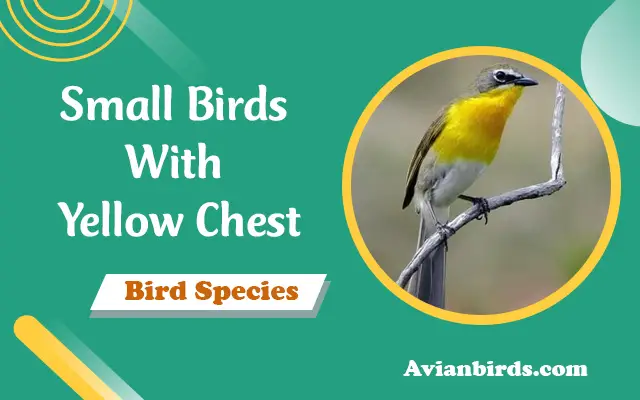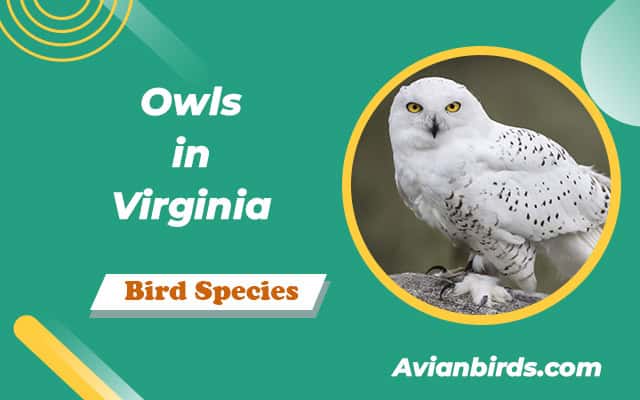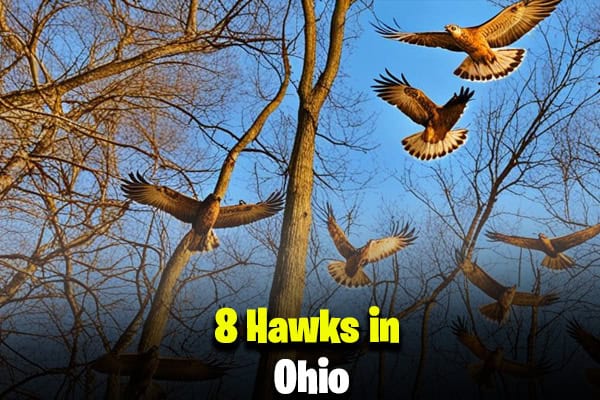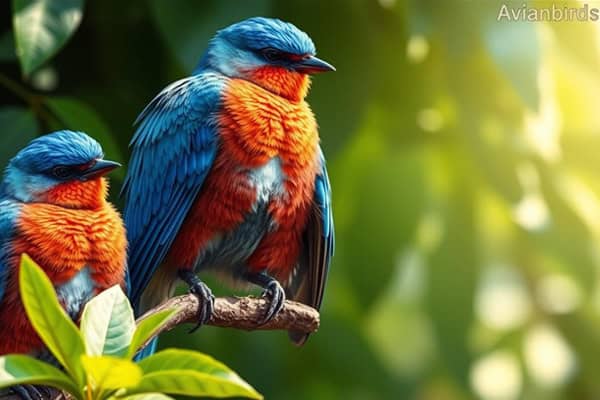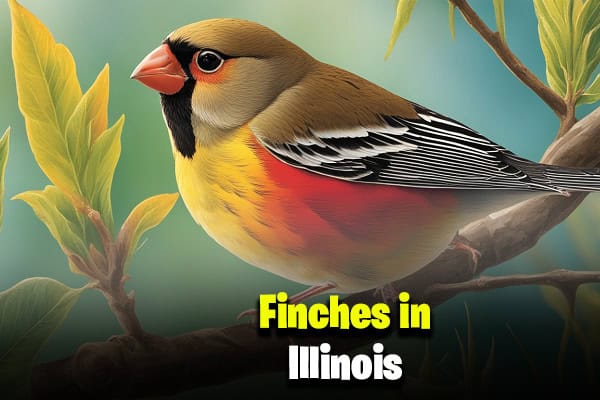Purple Birds Identification Guide: 48 Unique Species With Pictures
Purple birds possess a rare beauty that captures the attention of birdwatchers and nature enthusiasts. Below is a comprehensive guide to 48 species of purple birds from across the globe. Each entry includes detailed descriptions alongside a table highlighting key attributes like scientific name, size, habitat, diet, and distinctive features.
1. Purple-Breasted Cotinga
The Purple-Breasted Cotinga, a vibrant bird in the Amazon Basin, is known for its stunning purple and blue hues. Males exhibit a rich purple chest and bright blue head, while females are more muted in color.

| Attribute | Details |
|---|---|
| Scientific Name | Cotinga cotinga |
| Size | 18-20 cm |
| Habitat | Amazon Rainforest |
| Diet | Primarily fruits |
| Distinctive Features | Iridescent purple chest, blue head |
2. Violet-Crowned Hummingbird
This small hummingbird, common in Central America, sports a striking violet crown. It flits from flower to flower, sipping nectar with its slender beak and hovering with rapid wingbeats.
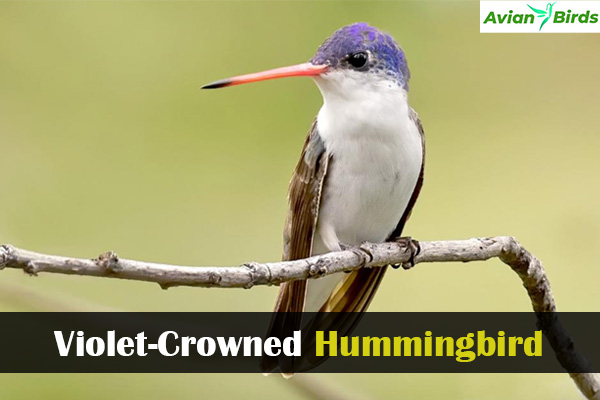
| Attribute | Details |
|---|---|
| Scientific Name | Amazilia violiceps |
| Size | 10-12 cm |
| Habitat | Woodlands, gardens |
| Diet | Nectar and insects |
| Distinctive Features | Violet crown, iridescent feathers |
3. Purple Martin
The Purple Martin is North America’s largest swallow, known for its sleek, glossy purple-black plumage in males. These birds are highly social and often nest in colonies near human settlements.

| Attribute | Details |
|---|---|
| Scientific Name | Progne subis |
| Size | 20 cm |
| Habitat | Open areas near water |
| Diet | Insects |
| Distinctive Features | Glossy purple-black color, colony-nester |
4. Violet-Backed Starling
Native to sub-Saharan Africa, the Violet-Backed Starling is often recognized for its vibrant plumage and is also known as the Plum-colored Starling. Males are primarily violet with white underparts, while females have more subdued coloring.
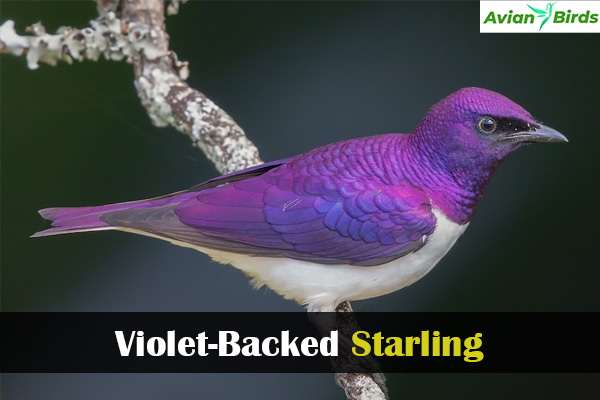
| Attribute | Details |
|---|---|
| Scientific Name | Cinnyricinclus leucogaster |
| Size | 17-19 cm |
| Habitat | Savannas, woodlands |
| Diet | Fruits, insects |
| Distinctive Features | Violet plumage, white belly in males |
5. Purple Sunbird
The Purple Sunbird, found in South and Southeast Asia, exhibits deep purple and metallic blue hues during breeding season, especially in males. These birds are small, agile, and known for their affinity to nectar.
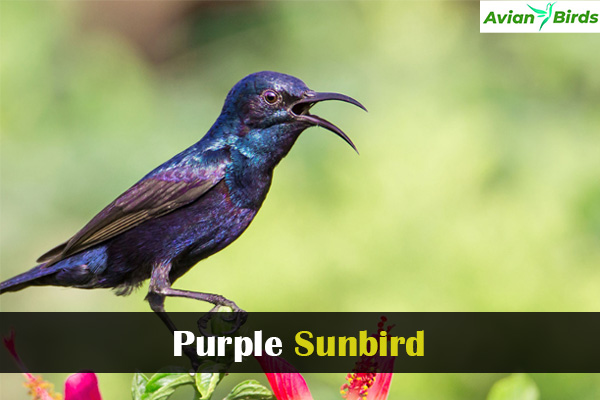
| Attribute | Details |
|---|---|
| Scientific Name | Cinnyris asiaticus |
| Size | 10 cm |
| Habitat | Gardens, forests, scrublands |
| Diet | Nectar, small insects |
| Distinctive Features | Deep purple, metallic sheen in males |
6. Varied Bunting
A North American bird, the Varied Bunting is prized for its mix of purple, red, and blue colors in males. These birds are commonly found in arid and semi-arid environments, where they nest in low shrubs.

| Attribute | Details |
|---|---|
| Scientific Name | Passerina versicolor |
| Size | 12-14 cm |
| Habitat | Desert scrub, thorn forests |
| Diet | Seeds, insects |
| Distinctive Features | Purple, blue, and red mix in males |
7. Splendid Sunbird
With iridescent purple, red, and blue hues, the Splendid Sunbird is a small, energetic bird found across tropical Africa. Males are particularly colorful, while females are more understated in appearance.
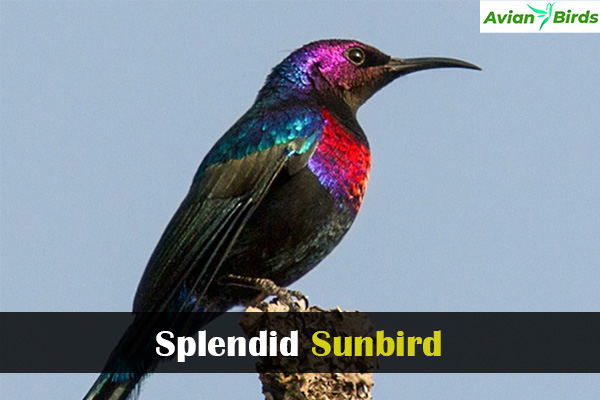
| Attribute | Details |
|---|---|
| Scientific Name | Cinnyris coccinigaster |
| Size | 12 cm |
| Habitat | Savannahs, woodlands |
| Diet | Nectar, insects |
| Distinctive Features | Iridescent purple and red feathers |
8. Purple Gallinule
Known for its colorful blend of purple, blue, and green, the Purple Gallinule is often spotted in marshes and swamps. This bird is notable for its vibrant plumage and long toes, which help it walk on floating vegetation.
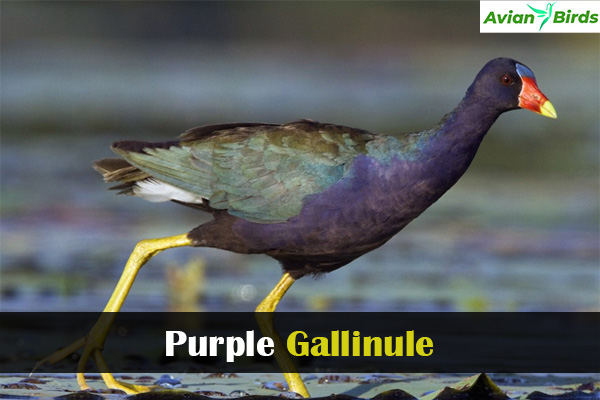
| Attribute | Details |
|---|---|
| Scientific Name | Porphyrio martinica |
| Size | 26-37 cm |
| Habitat | Marshes, wetlands |
| Diet | Seeds, small fish, insects |
| Distinctive Features | Purple-blue body, yellow legs |
9. Purple Honeycreeper
Found in the tropical forests of South America, the Purple Honeycreeper is a small, vibrant bird with a purple-blue body and contrasting black wings. Males are more vividly colored than females, who have a greenish hue.
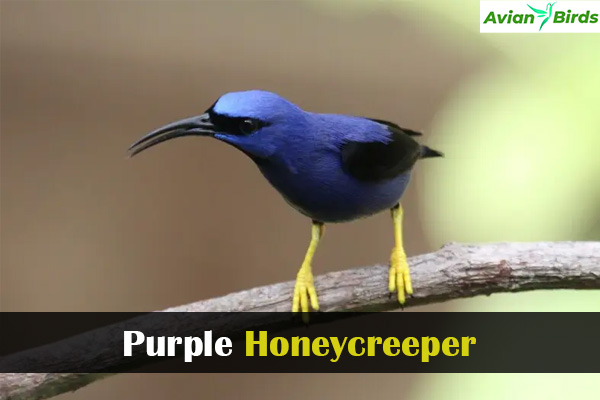
| Attribute | Details |
|---|---|
| Scientific Name | Cyanerpes caeruleus |
| Size | 10-11 cm |
| Habitat | Tropical forests, plantations |
| Diet | Fruits, nectar, insects |
| Distinctive Features | Purple body, black wings |
10. Purple Grenadier
This small, striking bird is native to eastern Africa, where it inhabits dry savannas and thorny shrubs. The male features a purple body with a bright red face, while females are mostly brown with touches of purple.

| Attribute | Details |
|---|---|
| Scientific Name | Uraeginthus ianthinogaster |
| Size | 13 cm |
| Habitat | Savannas, arid scrublands |
| Diet | Seeds, small insects |
| Distinctive Features | Purple body, red face in males |
11. Purple Swamphen
A large, colorful bird with shades of purple, blue, and green, the Purple Swamphen is often found near freshwater marshes. Known for its long red legs and red beak, it can walk over water vegetation with ease.
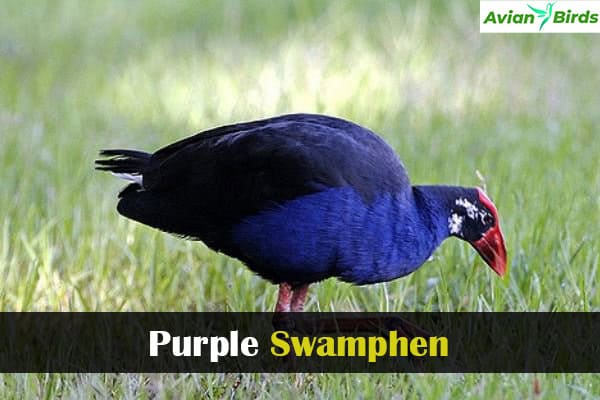
| Attribute | Details |
|---|---|
| Scientific Name | Porphyrio porphyrio |
| Size | 45-50 cm |
| Habitat | Freshwater marshes, wetlands |
| Diet | Aquatic plants, invertebrates |
| Distinctive Features | Purple-blue feathers, red beak |
12. Purple Finch
Native to North America, the Purple Finch is a small bird often confused with the House Finch. Males exhibit a rosy-purple color on their head and chest, while females are brown with streaks.
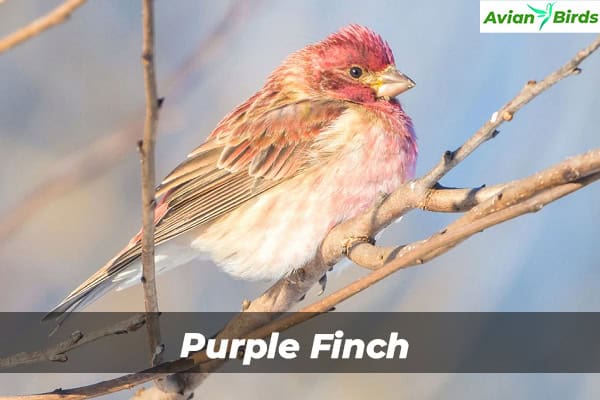
| Attribute | Details |
|---|---|
| Scientific Name | Haemorhous purpureus |
| Size | 15 cm |
| Habitat | Forest edges, parks, gardens |
| Diet | Seeds, berries, insects |
| Distinctive Features | Rosy-purple in males, streaked brown in females |
13. Asian Fairy Bluebird
A striking bird native to the forests of Southeast Asia, the Asian Fairy Bluebird exhibits a deep blue-purple plumage in males. Females are typically greenish-blue.
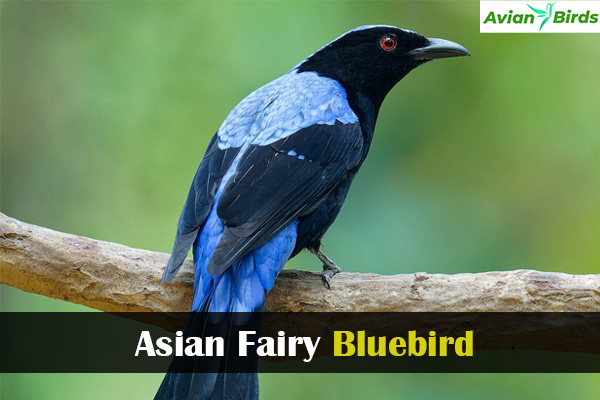
| Attribute | Details |
|---|---|
| Scientific Name | Irena puella |
| Size | 24-27 cm |
| Habitat | Tropical and subtropical forests |
| Diet | Fruits, nectar, insects |
| Distinctive Features | Deep blue-purple in males, long tail |
14. Purple-Crowned Lorikeet
The Purple-Crowned Lorikeet is native to southwestern Australia. This small parrot has a striking purple crown, with a body that combines green, yellow, and blue hues.
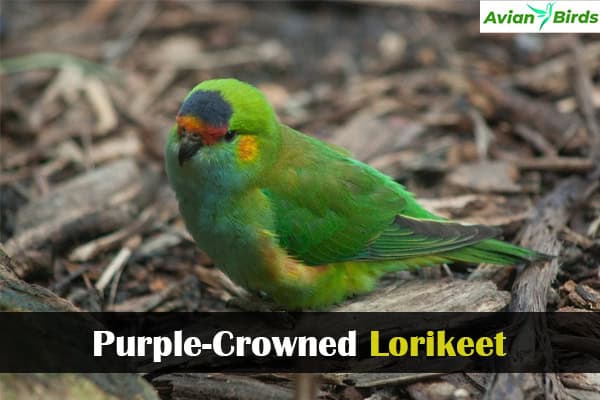
| Attribute | Details |
|---|---|
| Scientific Name | Glossopsitta porphyrocephala |
| Size | 15 cm |
| Habitat | Woodlands, forests, coastal regions |
| Diet | Nectar, pollen, fruits |
| Distinctive Features | Purple crown, vibrant multicolored plumage |
15. Rufous-Vented Chachalaca
This large bird, native to South America, has a dark brown and purplish body. It is found in tropical lowlands and is known for its loud calls and gregarious nature.

| Attribute | Details |
|---|---|
| Scientific Name | Ortalis ruficauda |
| Size | 50 cm |
| Habitat | Tropical lowlands, forests |
| Diet | Fruits, seeds, leaves |
| Distinctive Features | Purple-brown plumage, loud calls |
16. Purple Roller
Native to Africa, the Purple Roller is a large bird with a reddish-purple body, green wings, and blue accents. It is often seen perched high in trees, where it scans for prey.
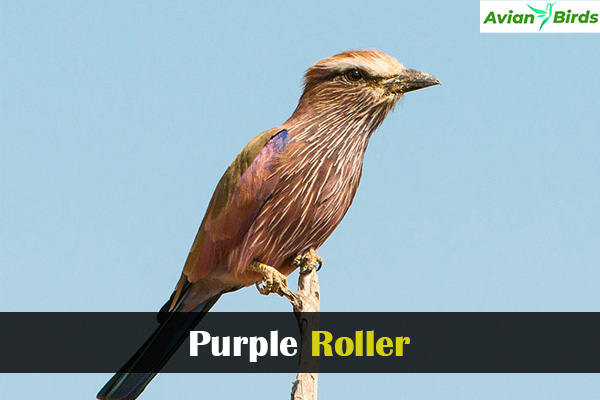
| Attribute | Details |
|---|---|
| Scientific Name | Coracias naevius |
| Size | 35-40 cm |
| Habitat | Savannas, woodlands |
| Diet | Insects, small reptiles |
| Distinctive Features | Reddish-purple body, green wings |
17. Purple-throated fruitcrow
A bird of the Amazon Basin, the male Purple-Throated Fruitcrow has a distinct purple throat that stands out against its otherwise black body. These birds are known for their loud, resonant calls.

| Attribute | Details |
|---|---|
| Scientific Name | Querula purpurata |
| Size | 27-29 cm |
| Habitat | Rainforests |
| Diet | Fruits, insects |
| Distinctive Features | Purple throat, loud calls |
18. Purple-Banded Sunbird
Found in East Africa, the Purple-Banded Sunbird has a vibrant purple band across its chest, set against a green and yellow body. This bird is typically seen hovering around flowers to feed on nectar.
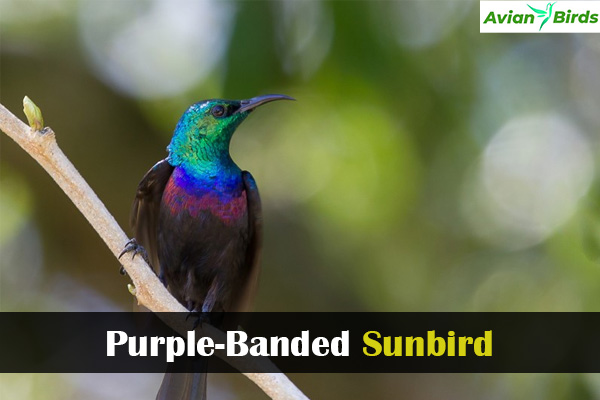
| Attribute | Details |
|---|---|
| Scientific Name | Cinnyris bifasciatus |
| Size | 10-11 cm |
| Habitat | Woodlands, savannas |
| Diet | Nectar, small insects |
| Distinctive Features | Purple chest band, small size |
Continuing with more purple bird species in markdown format, here are additional entries in the list, each with an informative table.
19. Purple-throated mountain gem
The Purple-Throated Mountain-gem, a hummingbird native to the mountains of Central America, is known for the vibrant purple throat of the male. This species lives in higher altitudes, hovering around flowers in search of nectar.
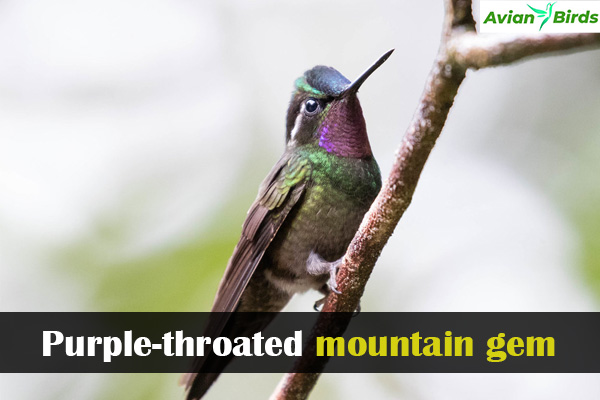
| Attribute | Details |
|---|---|
| Scientific Name | Lampornis calolaemus |
| Size | 10-12 cm |
| Habitat | Cloud forests, highlands |
| Diet | Nectar, small insects |
| Distinctive Features | Iridescent purple throat in males |
20. Purple-Crowned Fairy
A delicate, colorful hummingbird, the Purple-Crowned Fairy is recognized for its purple crown and white underparts. It flits gracefully through forests in Central and South America, feeding on nectar and small insects.
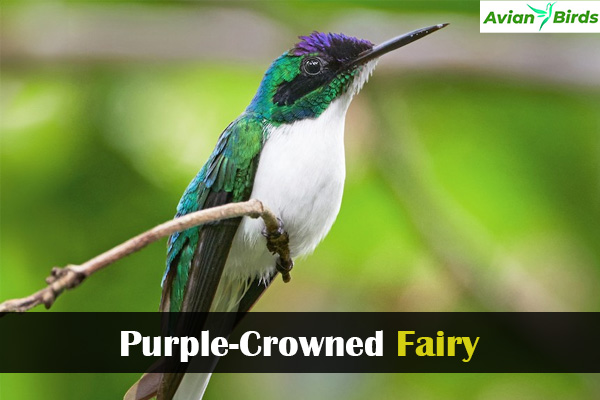
| Attribute | Details |
|---|---|
| Scientific Name | Heliothryx barroti |
| Size | 12 cm |
| Habitat | Rainforests |
| Diet | Nectar, small insects |
| Distinctive Features | Purple crown, white underparts |
21. Purple-Winged Roller
Native to Southeast Asia, the Purple-Winged Roller has a blend of blue and purple hues on its wings and body. It’s often found perched in open woodlands and feeds on insects and small reptiles.

| Attribute | Details |
|---|---|
| Scientific Name | Coracias temminckii |
| Size | 32-35 cm |
| Habitat | Forest edges, open woodlands |
| Diet | Insects, small reptiles |
| Distinctive Features | Purple wings, robust body |
22. Purple-Naped Lory
This striking parrot, native to Indonesia, has a beautiful combination of purple on its nape and green on its wings and body. Known for its bright colors, it is often seen in treetops, feeding on fruits and nectar.
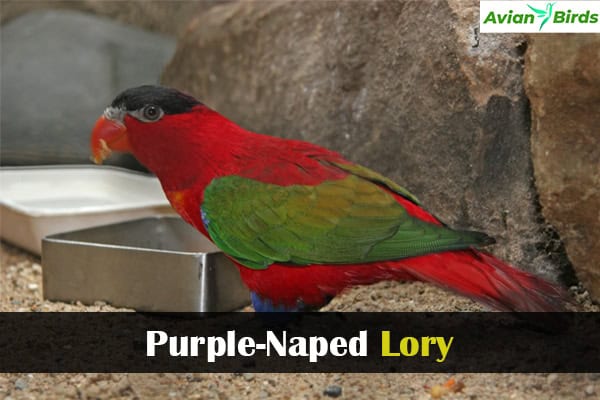
| Attribute | Details |
|---|---|
| Scientific Name | Lorius domicella |
| Size | 28-30 cm |
| Habitat | Tropical forests, coastal areas |
| Diet | Fruits, nectar |
| Distinctive Features | Purple nape, bright green body |
23. Amethyst Starling
The Amethyst Starling, also known as the Violet-Backed Starling, is native to sub-Saharan Africa. The male exhibits stunning iridescent purple plumage, making it one of the most vividly colored birds in its range.
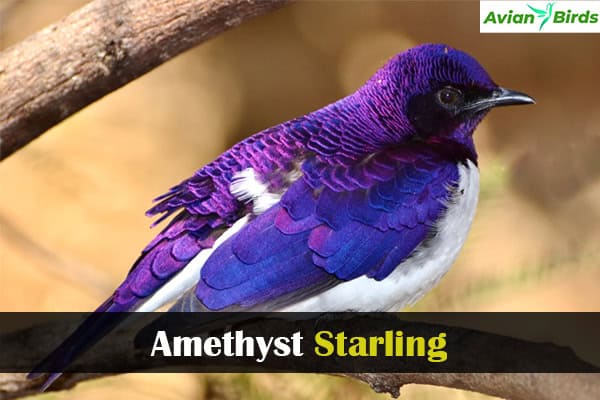
| Attribute | Details |
|---|---|
| Scientific Name | Cinnyricinclus leucogaster |
| Size | 17-19 cm |
| Habitat | Savannas, open woodlands |
| Diet | Fruits, insects |
| Distinctive Features | Iridescent purple body in males |
24. Purple-Coated Fruit-Dove
A rare and beautiful bird, the Purple-Coated Fruit-Dove has a mix of green and purple plumage. It’s mostly found in the tropical forests of Indonesia and feeds on various types of fruit.
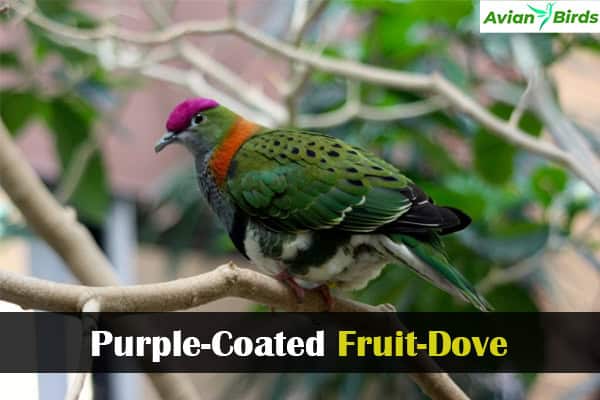
| Attribute | Details |
|---|---|
| Scientific Name | Ptilinopus porphyreus |
| Size | 22-24 cm |
| Habitat | Tropical rainforests |
| Diet | Fruits |
| Distinctive Features | Purple and green plumage |
25. Purple Starling
The Purple Starling, often found in sub-Saharan Africa, is known for its shiny, metallic purple feathers. These birds are often seen in flocks, especially in open areas where they search for insects.
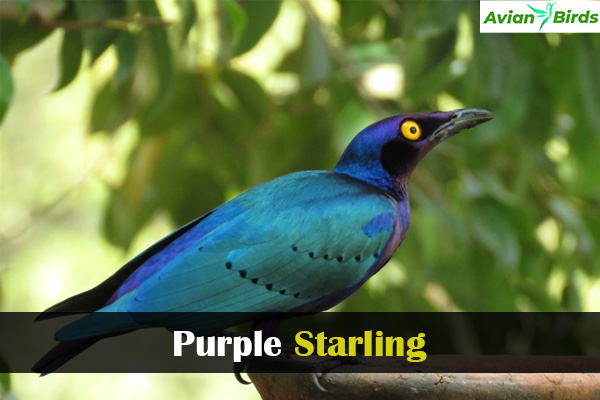
| Attribute | Details |
|---|---|
| Scientific Name | Lamprotornis purpureus |
| Size | 20-23 cm |
| Habitat | Woodlands, savannas, grasslands |
| Diet | Insects, fruits |
| Distinctive Features | Metallic purple plumage |
26. Reddish-Purple Sunbird
This vibrant species is known for its unique blend of purple and red feathers. The Reddish-Purple Sunbird is native to the forests of Southeast Asia, where it feeds on nectar and occasionally insects.
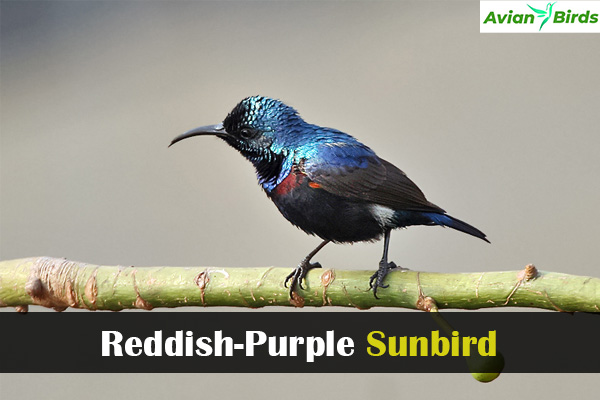
| Attribute | Details |
|---|---|
| Scientific Name | Aethopyga siparaja |
| Size | 12-13 cm |
| Habitat | Tropical forests, gardens |
| Diet | Nectar, small insects |
| Distinctive Features | Purple and red plumage |
27. Purple-Rumped Sunbird
Native to India and Sri Lanka, the Purple-Rumped Sunbird displays a combination of purple and green on its body. This small, energetic bird is commonly seen in gardens, where it sips nectar from flowers.
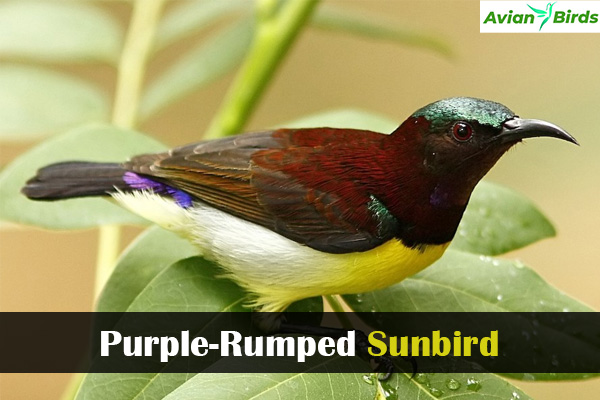
| Attribute | Details |
|---|---|
| Scientific Name | Leptocoma zeylonica |
| Size | 8-10 cm |
| Habitat | Gardens, forests |
| Diet | Nectar, insects |
| Distinctive Features | Purple rump, greenish back |
28. Purple-Bellied Lory
The Purple-Bellied Lory is a bright parrot from New Guinea with a unique mix of purple and red on its belly and head. This colorful bird is usually found in treetops, feeding on nectar, fruits, and pollen.
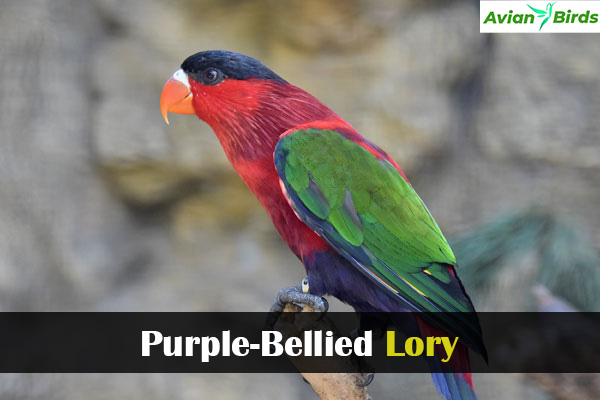
| Attribute | Details |
|---|---|
| Scientific Name | Lorius hypoinochrous |
| Size | 26-30 cm |
| Habitat | Tropical forests |
| Diet | Nectar, fruits, pollen |
| Distinctive Features | Purple belly, red head |
Continuing the list with more purple bird species, each entry below includes descriptive tables to facilitate identification and highlight each bird’s unique characteristics.
29. Purple-Backed Sunbeam
The Purple-Backed Sunbeam, native to Peru, is a rare hummingbird recognized for its iridescent purple back. Males and females have a blend of dark purple and green feathers.
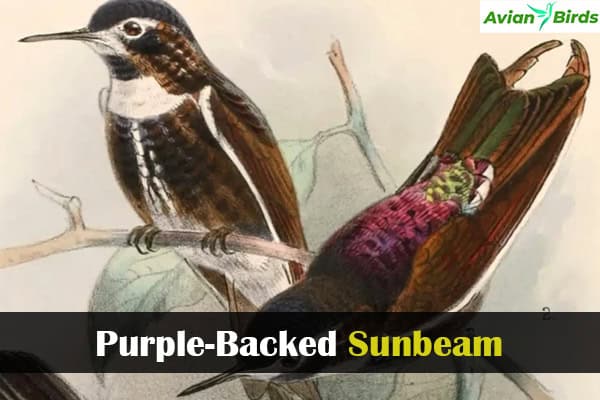
| Attribute | Details |
|---|---|
| Scientific Name | Aglaeactis aliciae |
| Size | 11-13 cm |
| Habitat | Cloud forests, highlands |
| Diet | Nectar, small insects |
| Distinctive Features | Iridescent purple back |
30. Purple-Fronted Parrotlet
This tiny parrot, native to South America, has a purple forehead with green and blue body plumage. It’s usually found in pairs or small flocks, feeding on seeds and fruit in forested areas.

| Attribute | Details |
|---|---|
| Scientific Name | Forpus xanthops |
| Size | 12 cm |
| Habitat | Tropical forests, woodlands |
| Diet | Seeds, fruits |
| Distinctive Features | Purple forehead, small size |
31. Purple-Winged Ground Dove
A critically endangered species from South America, the Purple-Winged Ground Dove has a soft purple tint on its wings and breast. Its elusive nature makes sightings rare.

| Attribute | Details |
|---|---|
| Scientific Name | Paraclaravis geoffroyi |
| Size | 15-16 cm |
| Habitat | Tropical and subtropical forests |
| Diet | Seeds, fruits |
| Distinctive Features | Purple wings, grayish body |
32. Purple-Winged Pigeon
The Purple-Winged Pigeon is a large bird native to the forests of Papua New Guinea. It has a distinct purple sheen on its wings, contrasting with its gray body, and is known for its soft cooing calls.
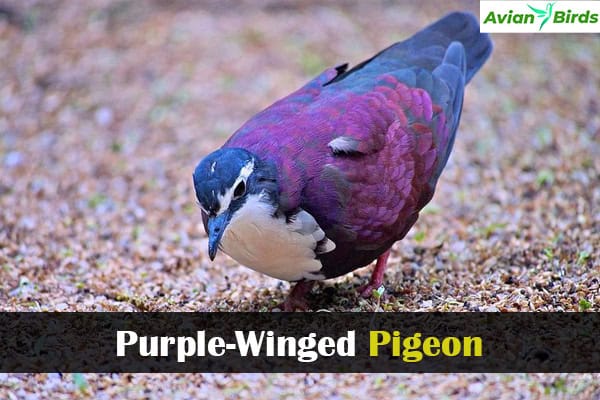
| Attribute | Details |
|---|---|
| Scientific Name | Ptilinopus magnificus |
| Size | 30-35 cm |
| Habitat | Forests, woodlands |
| Diet | Fruits, berries |
| Distinctive Features | Purple wings, soft cooing sounds |
33. Purple-Headed Parrotfinch
This small, lively bird from the tropical forests of Southeast Asia sports a unique purple head and a bright green body. Known for its acrobatic foraging, it feeds mainly on seeds and insects.
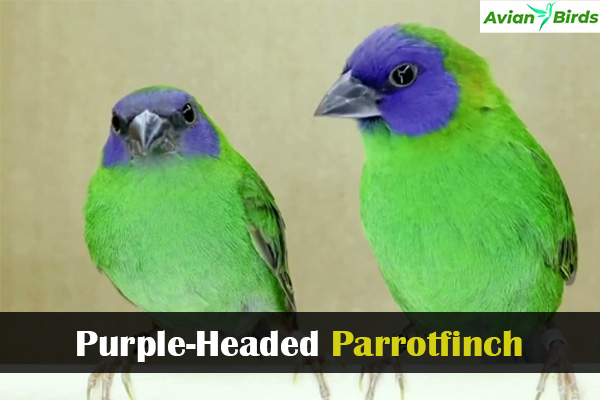
| Attribute | Details |
|---|---|
| Scientific Name | Erythrura cyaneovirens |
| Size | 11 cm |
| Habitat | Forest edges, gardens |
| Diet | Seeds, small insects |
| Distinctive Features | Purple head, bright green body |
34. Purple-Headed Lorikeet
A vibrantly colored lorikeet, the Purple-Headed Lorikeet is found in New Guinea. Its head is deep purple, while the body is adorned with red, green, and yellow. These birds are often seen in noisy flocks feeding on nectar.

| Attribute | Details |
|---|---|
| Scientific Name | Lorius domicella |
| Size | 27 cm |
| Habitat | Tropical rainforests |
| Diet | Nectar, fruits |
| Distinctive Features | Purple head, multi-colored body |
35. Purple-Breasted Sunbird
The Purple-Breasted Sunbird is an East African species known for the male’s glossy purple breast and contrasting dark green body. Females are more muted in color, with olive and brown tones.
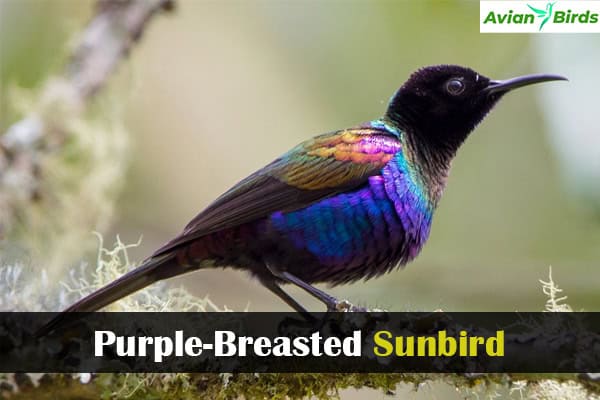
| Attribute | Details |
|---|---|
| Scientific Name | Nectarinia purpureiventris |
| Size | 12 cm |
| Habitat | Woodlands, savannas |
| Diet | Nectar, insects |
| Distinctive Features | Glossy purple breast in males |
36. Purple Finch
The Purple Finch, native to North America, is often mistaken for the House Finch. Males display a purplish-red wash on their body, while females are streaked brown.

| Attribute | Details |
|---|---|
| Scientific Name | Haemorhous purpureus |
| Size | 15 cm |
| Habitat | Forests, parks, gardens |
| Diet | Seeds, berries |
| Distinctive Features | Purplish-red plumage in males |
37. Violet Cuckoo
The Violet Cuckoo, found in Southeast Asia, has a striking purple body with a bright orange bill. This small, elusive bird is known for its high-pitched calls and rapid movements through dense foliage.

| Attribute | Details |
|---|---|
| Scientific Name | Chrysococcyx xanthorhynchus |
| Size | 17 cm |
| Habitat | Forests, mangroves |
| Diet | Insects, caterpillars |
| Distinctive Features | Purple body, orange bill |
38. Violet-Capped Woodnymph
This beautiful hummingbird, native to South America, features a violet cap and green plumage. Males are particularly eye-catching with their iridescent coloring, and they’re often seen hovering around flowers.

| Attribute | Details |
|---|---|
| Scientific Name | Thalurania glaucopis |
| Size | 11-12 cm |
| Habitat | Forests, gardens |
| Diet | Nectar, small insects |
| Distinctive Features | Violet cap, green body |
39. Purple-Crowned Fairywren
Native to Australia, the Purple-Crowned Fairywren is recognized for its purple crown and vibrant blue body. These small, social birds are often seen in family groups in open woodlands.
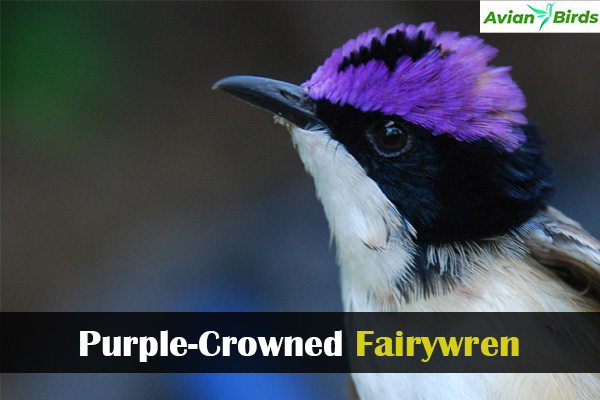
| Attribute | Details |
|---|---|
| Scientific Name | Malurus coronatus |
| Size | 11-12 cm |
| Habitat | Grasslands, woodlands |
| Diet | Insects, seeds |
| Distinctive Features | Purple crown, blue body in males |
40. Violet-Fronted Brilliant
The Violet-Fronted Brilliant is a colorful hummingbird from the Andean forests of South America. Males have a violet patch on their foreheads, while both sexes display vibrant green and bronze hues.
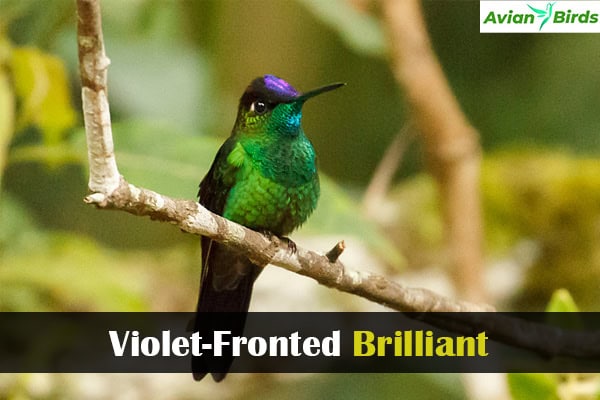
| Attribute | Details |
|---|---|
| Scientific Name | Heliodoxa leadbeateri |
| Size | 11-13 cm |
| Habitat | Cloud forests, montane regions |
| Diet | Nectar, insects |
| Distinctive Features | Violet forehead, metallic green body |
41. Purple-Crowned Fairy
The Purple-Crowned Fairy is a graceful hummingbird found in Central and South American rainforests. Its striking purple crown and long tail distinguish it from other hummingbirds in the region.

| Attribute | Details |
|---|---|
| Scientific Name | Heliothryx barroti |
| Size | 12 cm |
| Habitat | Rainforests |
| Diet | Nectar, small insects |
| Distinctive Features | Purple crown, long tail feathers |
42. Red-Legged Honeycreeper
This small bird of Central and South America displays vibrant blue-purple plumage, with red legs providing a contrasting accent. It’s often seen in pairs or small flocks searching for fruits and nectar.
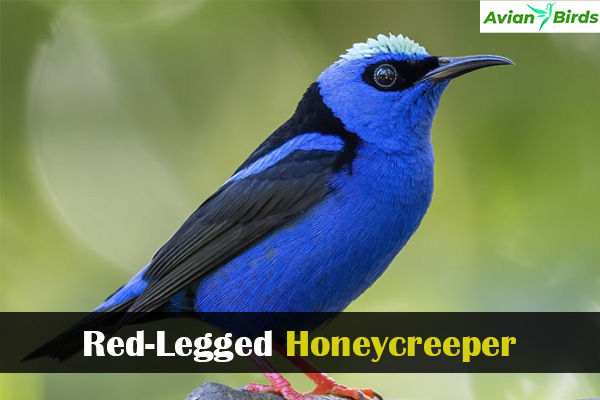
| Attribute | Details |
|---|---|
| Scientific Name | Cyanerpes cyaneus |
| Size | 10-12 cm |
| Habitat | Forests, plantations |
| Diet | Nectar, fruits, insects |
| Distinctive Features | Blue-purple body, red legs |
43. Purple-Throated Carib
Native to the Caribbean islands, the Purple-Throated Carib is a medium-sized hummingbird known for its vibrant purple throat and green body. Its curved beak is adapted for sipping nectar from deep flowers.
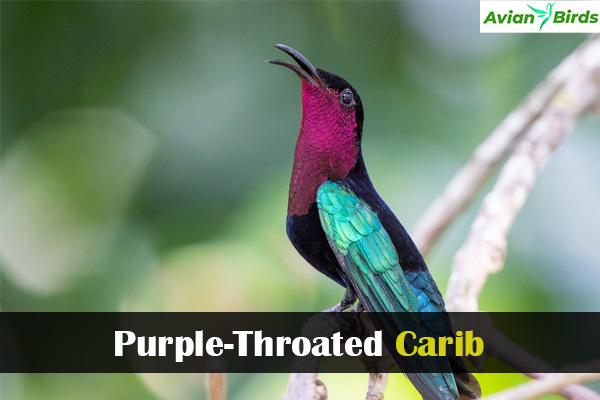
| Attribute | Details |
|---|---|
| Scientific Name | Eulampis jugularis |
| Size | 11-12 cm |
| Habitat | Tropical forests, gardens |
| Diet | Nectar, small insects |
| Distinctive Features | Purple throat, iridescent green body |
44. Violet-Bellied Hummingbird
A brilliantly colored species, the Violet-Bellied Hummingbird is native to Central and South America. Males exhibit a deep violet belly, while females are generally green with faint violet accents.
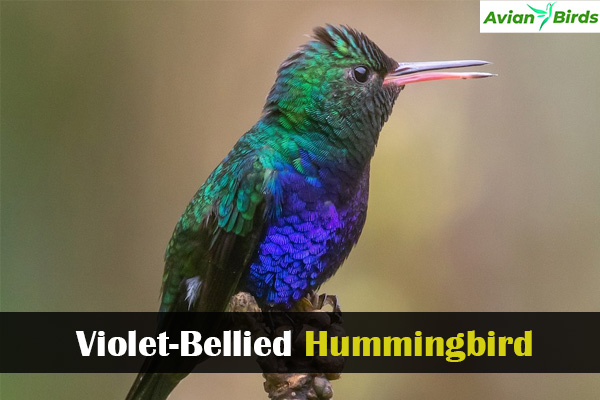
| Attribute | Details |
|---|---|
| Scientific Name | Juliamyia julie |
| Size | 10-11 cm |
| Habitat | Forests, gardens |
| Diet | Nectar, small insects |
| Distinctive Features | Violet belly, metallic green feathers |
45. Purple-Backed Sunbird
The Purple-Backed Sunbird, native to the Philippines, is known for the male’s stunning purple back and contrasting white underparts. They’re highly active, moving rapidly between flowers to feed on nectar.
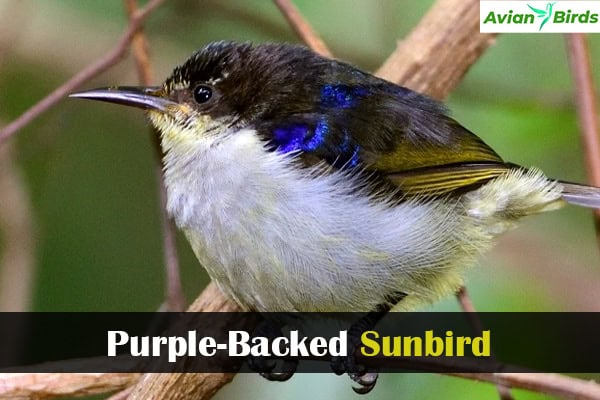
| Attribute | Details |
|---|---|
| Scientific Name | Leptocoma sperata |
| Size | 9-10 cm |
| Habitat | Forests, shrublands |
| Diet | Nectar, small insects |
| Distinctive Features | Glossy purple back, small size |
46. Violet-Crowned Plovercrest
This unique hummingbird from the Brazilian highlands features a violet crown and a long, crest-like feather on its head. Known for its distinctive calls, it’s usually found in open woodlands and scrublands.
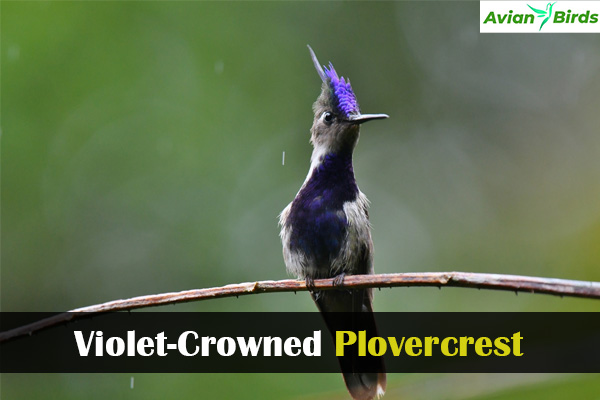
| Attribute | Details |
|---|---|
| Scientific Name | Stephanoxis lalandi |
| Size | 11 cm |
| Habitat | Woodlands, scrublands |
| Diet | Nectar, small insects |
| Distinctive Features | Violet crown, crest-like feather |
47. Violet-Necked Lory
The Violet-Necked Lory, found in New Guinea and nearby islands, has a unique violet neck and green and red body, which allows it to blend into tropical forest foliage while feeding on nectar and fruit.

| Attribute | Details |
|---|---|
| Scientific Name | Eos squamata |
| Size | 26-28 cm |
| Habitat | Tropical rainforests |
| Diet | Nectar, fruits |
| Distinctive Features | Violet neck, bright red and green plumage |
48. Purple Sunangel
The Purple Sunangel is an elusive hummingbird species found in Andean cloud forests. Males have a remarkable violet and blue iridescent throat, while females are slightly more subdued in coloration.
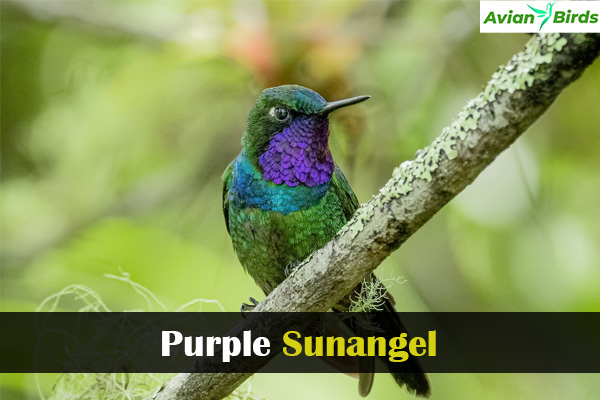
| Attribute | Details |
|---|---|
| Scientific Name | Heliangelus viola |
| Size | 10-12 cm |
| Habitat | Cloud forests |
| Diet | Nectar, small insects |
| Distinctive Features | Iridescent purple throat in males |
Our Recommended Articles To Read
Frequently Asked Questions
Q1. What makes a bird’s feathers appear purple?
Purple coloration in birds is often due to structural color, where feather microstructures reflect light in specific ways, rather than pigments.
Q2. How can I identify purple birds in the wild?
Look for iridescent or deep violet hues, especially on the head, chest, or wings. For detailed species information, consult field guides or identification apps.
Q3. Are purple birds rare?
Many purple birds are found in tropical or specific ecosystems, making them less common in temperate zones but frequently sighted in rainforests and coastal regions.
Q4. Do purple birds use their color for camouflage?
In some cases, purple helps with camouflage among flowers or in shaded forest areas, but it’s often used to attract mates or deter rivals.
Q5. What do purple birds typically eat?
The diet of birds varies but commonly includes nectar, fruits, insects, and seeds. Hummingbirds and sunbirds, for example, favor nectar and small insects.
Q6. Can I attract purple birds to my backyard?
Yes, by planting native flowering plants, providing nectar feeders, and creating a habitat with shrubs and trees.
Q7. What is the most famous purple bird?
The Purple Martin is well-known in North America and frequently attracts birdwatchers due to its social nature and glossy purple-black feathers.
Q8. Where are most purple birds found?
Many species are native to tropical and subtropical regions like Southeast Asia, Central and South America, and parts of Africa.
Q9. Why do male purple birds often have brighter colors than females?
Bright colors in males serve as a visual signal to attract females and establish dominance, especially during breeding season.
Q10. Are purple parrots common?
Some purple parrot species, like the Violet-Necked Lory, are found in specific regions, but purple is rare among parrots.
Q11. What role does the purple color play in mating?
In many species, males display vibrant purple feathers to attract females, signaling good health and strong genetics.
Q12. What types of habitats support purple birds?
Depending on the species, purple birds are found in rainforests, savannas, woodlands, coastal regions, and even wetlands.
Q13. How can I photograph purple birds effectively?
Use natural light, and photograph in the early morning or late afternoon for the best lighting. A zoom lens helps capture detail without disturbing the bird.
Q14. Are any purple birds endangered?
Yes, species like the Purple-Winged Ground Dove are critically endangered due to habitat loss and hunting.
Q15. What is structural coloration in birds?
Structural coloration occurs when feather microstructures reflect specific wavelengths, resulting in colors like purple, blue, and green.
Q16. Do purple birds migrate?
Yes, some species, like the Purple Martin, are migratory, traveling between North and South America seasonally.
Q17. Which bird has the deepest purple feathers?
The Violet-Backed Starling and the Purple-Crowned Lorikeet are known for their rich, deep violet hues.
Q18. How does the purple color help birds in the wild?
Besides mating, it can help with camouflage in forested or flowery environments, where purple tones blend well.
Q19. What is the lifespan of purple birds?
Lifespan varies; small birds like hummingbirds live 3-5 years, while larger species like Purple Martins can live up to 10 years in the wild.
Q20. What’s the difference between purple and iridescent purple feathers?
True purple feathers have pigments, while iridescent purple feathers change color with light due to structural coloration.
Final Reflections
Purple birds are a unique group that captivates bird enthusiasts worldwide with their brilliant hues, intricate behaviors, and diverse habitats. Their color, often from specialized feather structures rather than pigments, makes them visually striking and highly prized for observation and photography. Encountering these birds offers a glimpse into the complex beauty of avian life, highlighting the importance of preserving their habitats for future generations.



